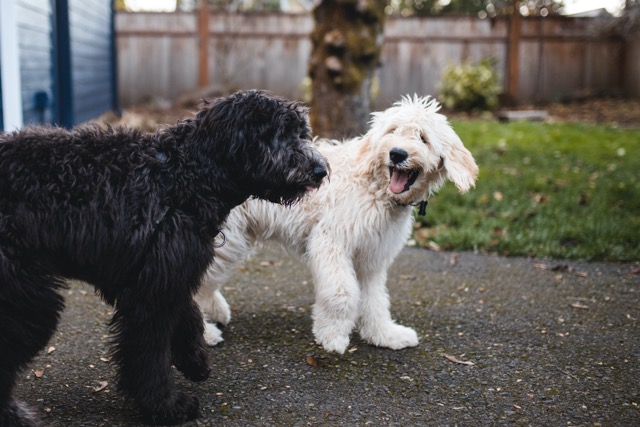Reactivity is one of the more misunderstood dog behaviors. As a Certified Applied Animal Behaviorist, dog reactivity is one of the most common behaviors I treat. After nearly two decades of studying reactivity in dogs, I’ve observed hundreds, if not thousands, become reactive while on leash. What is very interesting about these cases is that many of them are not reactive when off-leash. This leads my clients down a bumpy road of confusion, and I often hear reports that their dogs are “barking because they want to play” or “because they want to say hi.” Most of these reports are inaccurate when I analyze the individual dog’s reactivity. This is what I have learned.
The most common misconception about reactivity
One of the most common misconceptions about reactivity is that a dog wants to say hello or play. That is usually not the case, but there are always exceptions. Look at a few things to know whether a dog is reactive or truly wants to say hi or play. When broadly identifying this across dogs, I consider the dog’s age. If a dog is over the age of 2 years, I consider barking while on a leash for attention to be rare. It is not to say it never happens, but it is rare.
Conversely, it is rare for dogs under 12 weeks to be reactive on a leash. I also consider each dog’s breed and how their parents and grandparents behaved (if I’m lucky enough to know!). Unfortunately, that still gives pet parents much room to question their dog’s behavior!
I usually take it a step further and initially assume any dog under 8 months is barking for attention, and those over 8 months are barking as a sign of reactivity. But that only gives us broad categorizations. Then what?

Like any other behavior, I look at the dog’s body language to give me a clearer picture. Specifically, I look at these 4 things:
- The dog’s body and whether it is stiff and leaning forward or loose and bouncy
- The dog’s eyes and if they are staring or looking loosely at the target
- The dog’s ears and whether they are rigid and pointed toward the target or neutral, sometimes even pinned backward
- The dog’s mouth and whether or not it is open or closed immediately before the bark.
The dog’s age, breed, and, most importantly, body language help me determine whether a dog is reactive or the exception to the rule!
Why are dogs reactive?
After dispelling the most common myth surrounding reactivity, the next thing to understand is why dogs become reactive. Dogs are reactive to distance themselves from unfamiliar people or dogs. In most cases, the reactivity works, and the behavior is paid when the unfamiliar person or dog moves away. Consider a dog who becomes reactive on a walk. The owner and the other person continue moving, creating distance even if creating that distance is unintentional. The walk continues, and the dog’s reactivity resulted in an increased distance from the target. The distance that was created strengthens the dog’s reactivity in the future.
Reactivity is, unfortunately, a double-edged sword. Reactivity is either reinforced by the increased distance or, worse, strengthened when the distance from other people or dogs is not increased. The reactivity is shaped into biting when it is no longer reinforced by removing the other person or dog. This phenomenon is called extinction. When the dog does bite, the bite is almost guaranteed to result in the removal of the person or other dog.
Motivation when a dog is off leash vs. on leash
Suppose the purpose of reactivity is to increase the distance between the dog and the unfamiliar person or dog. In that case, it makes sense why dogs are more reactive on leash vs. off leash when considering the level of motivation the leash creates. When dogs are off-leash, they can control the distance between themselves and people or dogs. The less motivated they are to become reactive. The larger the space, the more control they have and the more likely they will do other things besides becoming reactive to create that space. When dogs are on a leash, the opportunity to move away and create space is completely out of their control. We miss their subtle cues and continue moving closer to what they may view as a potential threat—the motivation to become reactive increases dramatically. Dogs then begin barking or lunging, and we quickly notice, and the space is then created. The vicious cycle continues; we are lucky if the behavior does not become more than barking or lunging.

Knowing whether your dog is reactive, why they become reactive, and understanding why dogs behave differently on leash vs. off-leash is the first step to helping your reactive dog. The great news is that it is treatable once reactivity has been identified. Our team uses a combination of classical conditioning–pairing the presence of the threat with something pleasant—and positive reinforcement-based obedience training to treat this common problem behavior.




